|
Thurs., May 31
THERE WILL BE NO ALCPG ILC PHYSICS AND DETECTOR SEMINAR THIS WEEK
3:00 p.m.
Joint Theory-CMS Seminar - Curia II (NOTE TIME)
Speakers: K. Burkett and P. Skands, Fermilab
Titles: Preparations for Early LHC Physics: CMS;
Preparations for Early LHC Physics: Theory
3:30 p.m.
DIRECTOR'S COFFEE BREAK - 2nd Flr X-Over
THERE WILL BE NO ACCELERATOR PHYSICS AND TECHNOLOGY SEMINAR TODAY
Fri., June 1
3:30 p.m.
DIRECTOR'S COFFEE BREAK - 2nd Flr X-Over
4:00 p.m.
Joint Experimental-Theoretical Physics Seminar - 1 West
Speaker: G. Zeller, Columbia University
Title: Neutrino Cross Section Physics: Past, Present and Future
May 30 - June 3
NuInt07
Fifth International Workshop on Neutrino-Nucleus Interactions in the Few-GeV Region
Click here for more information.
Click here for NALCAL,
a weekly calendar with links to additional information. |
Thursday, May 31
-Minnesota wild rice w/chicken
-Tuna melt on nine grain
-BBQ ribs
-Chicken casserole
-Buffalo chicken wrap
-Assorted sliced pizza
-Toasted pecan chicken salad
*Carb Restricted Alternative
Wilson Hall Cafe Menu |
|
Thursday, May 31
Dinner
- Smoked salmon napoleon
- Veal saltimbocca
- Orzo w/pine nuts, arugula & parmesan
- Steamed asparagus
- Olive oil, orange & almond cake
Wednesday, June 6
Lunch
- Salad nicoise w/fresh grilled tuna
- Pear tart
Chez Leon Menu
Call x4598 to make your reservation. |
|
|
URA selects Tim Scanlon
as thesis competition winner
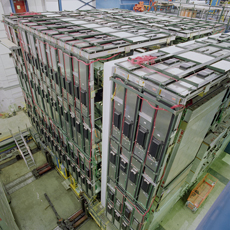
The DZero detector, shortly after run 1, in asssembly hall.
Each year, the URA Thesis Award Committee bestows a plaque and a check on a deserving graduate at the annual Users Meeting. This year is no exception, with the committee unanimously choosing to honor Tim Scanlon, a graduate student at Imperial College, London while he was working as a collaborator on DZero.
Scanlon's thesis, "b-Tagging and the Search for Neutral Supersymmetric Higgs Bosons at DZero," discusses the efforts to develop an artificial neural network to recognize b-jets and reject other, short-lived jets using information available about jet lifetime. The neural network b-tagging tool greatly increased DZero's ability to identify b-jets, increasing their b-tagging efficiency by more than 30 percent. "The improvement increases Fermilab's chances of finding the Higgs. Scanlon used his method to search for neural supersymmetric Higgs bosons in multi-jet data.
"As the Higgs decays to two b-jets, and as most of the jets in our background contain no b-jets, identifying b-jets is a powerful tool that allows us to massively increase the number of signal events compared to a number of background events," Scanlon said. His thesis also included his work on improving the trigger tracking code and in leading the development of a b-tagging tool that searches for secondary decay points at the trigger level.
"I'm delighted that Tim has won this award. He's made major contributions to the experiment in several areas: developing a neural net b-tagger, improving the
Level-3 tracking code and in the hbb analysis," said Gavin Davies, Scanlon's advisor at Imperial College London.
Scanlon's thesis was chosen from among 15 nominations for its superior combination of originality, physics content and clarity of presentation. "Tim's dissertation, for most of us, was a complete body of work," said Fermilab's Rick Tesarek, chair of the URA Thesis Committee. "He was able to describe both experience and analysis, and it was clear that he had made substantial contributions to the experiment."
On Thursday, June 7, at the Users' meeting, Scanlon will receive a plaque and a $3,000 award funded by the Universities Research Association. He will also give a short talk about his thesis research. View Scanlon's thesis here.
-- Rhianna Wisniewski
|
EU-IndiaGrid: Building a Partnership Across Hemispheres
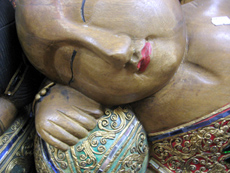
Sleeping giant: India's grid potential is huge but so far largely untapped.
Image courtesy of morgueFile
Over the last 10 years, India has posted an average annual growth rate of more than 7%. India's success in the IT field has been especially dazzling; it is already a major exporter of software services and software engineers.
Despite these advances, the nation still faces pressing problems and currently lacks the computing infrastructure required to fully use modern technology and its educated population.
EU-IndiaGrid, the first project of its kind, seeks to join grids in Europe and India and promote research in both regions.
"Our main goal is to establish a collaboration between India and Europe and to support the evolution of Indian grid interests," says the project's manager, Alberto Masoni.
The key elements of this support are infrastructure and interoperability: two golden words of the grid world.
EU-IndiaGrid has eleven partner institutions: six in India and five in Europe. These institutions are connected via the EU-IndiaGrid testbed, one of the first steps towards a production-level grid.
"Our testbed is small," says Masoni. Then he adds with a smile: "But it is working."
Read More
|
From NBC5 News
May 30, 2007
In the local evening news, NBC Channel 5 reported on the race for finding the Higgs boson. Watch the 3-minute video here.
(The video also includes some footage of the unrelated MiniBooNE experiment.)
|
From The Seattle Times
May 30, 2007
Lab buried under ski slope would tackle cosmic puzzles
SCENIC, King County - Deep in the granite thousands of feet directly below the Seventh Heaven chairlift at Stevens Pass ski area, white-suited scientists may one day walk through a series of dust-free chambers to figure out how matter came to exist in the universe.
That's the vision of University of Washington physicist Wick Haxton. And sometime in the next few weeks, Haxton and the rest of the world will find out whether it's likely to come true. After the UW-led team twice appeared to be knocked out of contention, it now finds itself in the final stretch of a yearslong competition among four sites competing to build one of the world's deepest underground laboratories.
Read more
|
|
|
The difference between even and odd
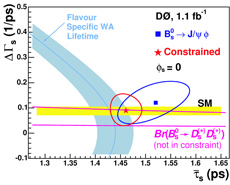
This figure shows a combination of all DZero results on the lifetime difference between CP-even and CP-odd eigenstates in the Bs meson system. The measurement of Br(Bs -> Ds(*)Ds(*)), constrained between the two pink lines, gives an estimate of the lifetime difference consistent with another DZero measurement using Bs -> J/psi phi decay, featured here.
Physicists have had great success describing the universe via fundamental symmetries. For example, we know that if the Tevatron was in Alaska, we would still get the same results we obtain here in Batavia. This is because physical laws are symmetric under spatial transformations. However, there are transformations under which physics is unexpectedly not symmetric: mirror symmetry ("P") and charge reversal ("C"), and their combination ("CP") being classics. Imagine how odd it would be if your mirror image did not exactly mimic your movements. Using mirror symmetry as an example, we can separate properties into those that do not change under reflection (P-even) and those that do change (P-odd). Sit down and you'll see your reflection sit at exactly the same time: time is P-even. Hold up your hand and it appears your hand is inside the mirror on the wrong side of your body: spatial coordinates are P-odd.
The difference between even and odd particles is demonstrated very clearly by particles such as the Bs meson, which is a bound state of beauty and strange quarks. The Bs meson is really an admixture of two states: one CP-even and one CP-odd. But, curiously, the CP-odd state seems to live longer before decaying. By understanding this behavior, physicists can turn back the clock and learn details about how our universe evolved.
Physicists at the DZero experiment have recently measured how much longer the CP-odd Bs state lives than its CP-even brethren. In 1.3 inverse femtobarns of data, DZero physicists have measured the rate at which neutral Bs mesons decay to two Ds(*) mesons, which are bound states of charm and strange quarks. This measurement requires the ultimate detection of six particles which reconstruct the full system. By carefully separating true Bs->Ds(*)Ds(*) decays from the many other final states seen in the DZero detector, scientists measured the fraction of Bs->Ds(*)Ds(*) decays to be 0.039±0.024. This value is consistent with both the Standard Model prediction and previous measurements made with lower precision. Because the difference in lifetimes between the two Bs states is closely linked to the fraction of Bs->Ds(*)Ds(*) decays, physicists are now one step closer to understanding the strange Bs meson, and, indeed, to understanding our strange universe.
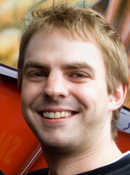 |
James Walder of Lancaster University made primary contributions to this analysis. |
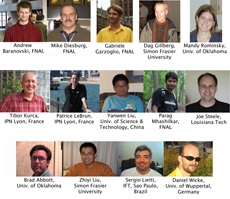
The DZero reprocessing team manages the large challenge of processing DZero's ever-growing collected data sample. This effort is crucial for all DZero analyses. (Not pictured: Sohrab Hossain)
|
|
Pine Street closures Monday and Tuesday
On Monday and Tuesday, June 4 and 5, utility trenching and pavement marker installation activities will require partial closures of Pine St. Inbound Pine St. will be closed Monday from 8:00 a.m. until 6:00 p.m. On Tuesday, outbound Pine St. will be closed from 7:30 a.m. until 5:00 p.m. Weather conditions could alter this schedule. Check Fermilab Today for weather-related schedule changes. Please use the Wilson St. gate as the detour route. Notice and detour signs will be posted.
Outreach workshop on June 5
The Fermilab Users' Organization will host an Outreach Workshop on June 5, 2007, the day before the Users meeting. The workshop will be held from 9:00 a.m. to 5:00 p.m. in One West. It is an opportunity to exchange ideas on effective and practical ways to communicate the exciting ideas of physics. Click here for more information.
Bob Betz memorial symposium
A memorial celebration of the life of Dr. Robert F. Betz and his lasting influence on Fermilab and the region will take place on Saturday, July 7, at
2 p.m. in Ramsey Auditorium. The event will highlight the great contributions that Bob made to prairie conservation and restoration in
Illinois, in particular his work at Fermilab and its National Environmental Research Park. Please RSVP to x5422. Click here
for more information.
DASTOW 2007
On June 21, Fermilab will hold this year's Daughters and Sons to Work day (DASTOW). Please check the DASTOW Web site for more information.
Additional Activities
|
|